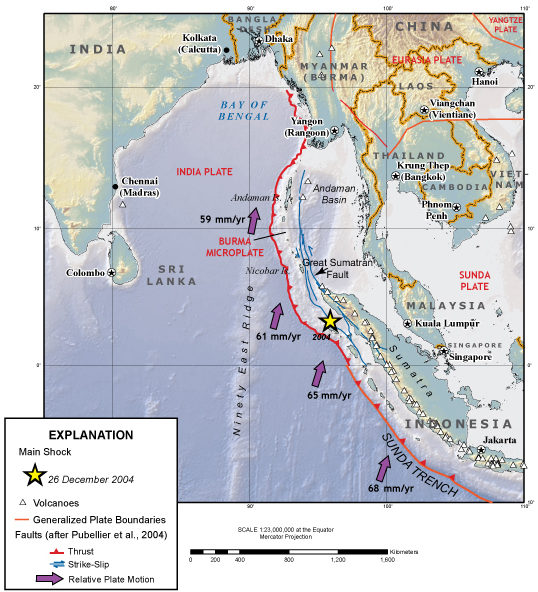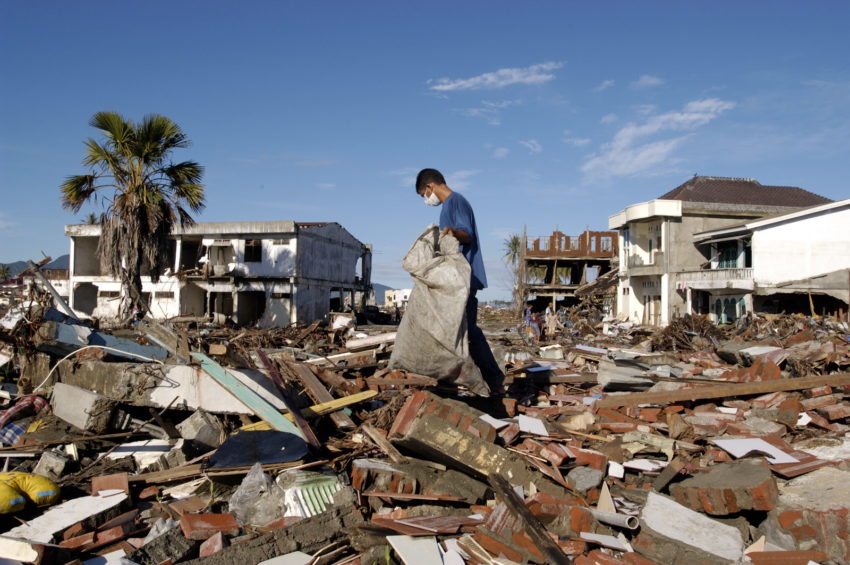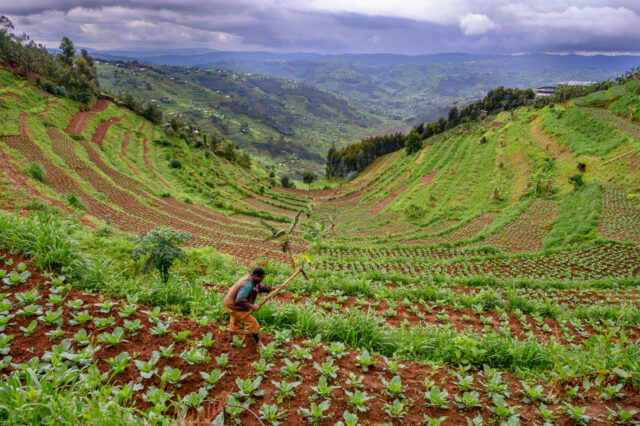The 2004 Indian Ocean earthquake and tsunami, one of the most powerful natural disasters in recorded history, sent shockwaves through the region, impacting multiple countries and hundreds of thousands of lives. A massive undersea earthquake off the western coast of northern Sumatra, Indonesia, unleashed a series of colossal tsunamis that inundated coastal areas, catching communities off-guard and causing widespread destruction. The disaster not only brought immediate loss of life and destruction to infrastructure but also prompted a global reflection on the vulnerabilities of coastal regions and the importance of disaster preparedness and international collaboration.
2004 Indian Ocean Tsunami: Facts, FAQs, and how to help
Explore facts and frequently asked questions about the 2004 Indian Ocean earthquake and tsunami, and learn how you can help people affected by disasters around the world.
-
- Fast facts: 2004 Indian Ocean earthquake and tsunami
- Why was the 2004 Indian Ocean tsunami so destructive and deadly?
- How did World Vision help people recover from the 2004 Indian Ocean earthquake and tsunami?
- How does World Vision respond to disasters around the world?
- How can I help people affected by earthquakes, tsunamis, and other disasters?
Fast facts: 2004 Indian Ocean earthquake and tsunami
- Approximately 230,000 people died in the 2004 Indian Ocean earthquake and tsunami, making it one of the deadliest disasters in modern history.
- The Sumatra-Andaman earthquake, which caused the tsunami, is estimated to have released energy equivalent to 23,000 Hiroshima-type atomic bombs.
- The earthquake struck 150 miles from the coast of Sumatra Island, on the northwest of the Indonesian island group, and 31 miles below the ocean floor.
- In Banda Aceh, the landmass closest to the quake’s epicenter, tsunami waves topped 100 feet. The tsunami’s waves traveled across the Indian Ocean at 500 mph, the speed of a jet plane.
- The 2004 Indonesia earthquake caused a shift in the earth’s mass, changing the planet’s rotation.
- Total material losses from the tsunami were estimated at $10 million.
- Indonesia lies between the Pacific Ring of Fire, where 90% of earthquakes occur, and the Alpide belt, the second-most active seismic zone,.
Why was the 2004 Indian Ocean tsunami so destructive and deadly?
The first giant waves from the Indian Ocean tsunami reached Banda Aceh, an Indonesian city of about 300,000 people, within 15 or 20 minutes of the earthquake. Few residents of the densely populated area realized that the earthquake they had felt could cause a tsunami, and there was little time to flee to higher ground.
Traveling as fast as 500 mph, the waves spread to other countries, including India, Myanmar, Sri Lanka, and Thailand. With no warning, coastal populations were caught by the pounding waves. Many families that made their living fishing lost everything; the tsunami wiped out whole communities.

How did World Vision help people recover from the 2004 Indian Ocean earthquake and tsunami?
In the aftermath of the 2004 Indian Ocean earthquake and tsunami, World Vision played a pivotal role in supporting the recovery efforts across five countries: India, Indonesia, Myanmar, Sri Lanka, and Thailand. Through our extensive relief operations, we raised more than $350 million and led one of our most substantial responses. Our impact included:
Livelihoods empowerment and education: We offered training and employment opportunities to 40,000 people, conducted child-rights awareness sessions for more than 27,000 people, and extended educational support to over 2,000 teachers and 137,000 children.
Infrastructure and community development: World Vision built 12,000 homes to provide shelter for families, established 200 Child-Friendly Spaces to aid children’s recovery, constructed 84 schools and 60 playgrounds to help restore a sense of normalcy, and set up 27 health clinics to deliver essential medical services.
Sustainable restoration: Our teams implemented coastal restoration programs by planting 56,000 mangroves to serve as a natural barrier to rising ocean levels. We also helped in the restoration of a fishing harbor.
Most of World Vision’s tsunami-related rehabilitation was successfully completed by 2007. However, our impact endures through many ongoing initiatives, as today, World Vision’s child sponsorship, health, education, water, food, agriculture, and livelihoods programs continue to flourish across countries that were affected by the devastating tsunami.
How does World Vision respond to disasters around the world?
Drawing on decades of experience and a global network of trained emergency staff, World Vision responds to major crises, from earthquakes and hurricanes to conflict and droughts.
In 2022 alone, World Vision responded to 59 humanitarian emergencies in 52 countries, supporting over 27.7 million people with essential assistance.
Our response includes providing food, access to clean water, hygiene items, and other essential supplies while promoting disease prevention through hygiene training. Child protection initiatives address urgent cases such as family separation and violence. We also offer health, nutrition, and educational services.
We aim to support families during crises and guide them through the rebuilding process. World Vision collaborates with communities to reconstruct homes, establish permanent housing, secure clean water access, ensure food security, and deliver quality education.
How can I help people affected by earthquakes, tsunamis, and other disasters?
- Pray: Join us in praying for families and communities as they recover and rebuild after disasters.
- Give: Your gift will help provide essential care to children and families affected by disasters.
Sevil Omer of World Vision’s U.S. staff contributed to this article.



